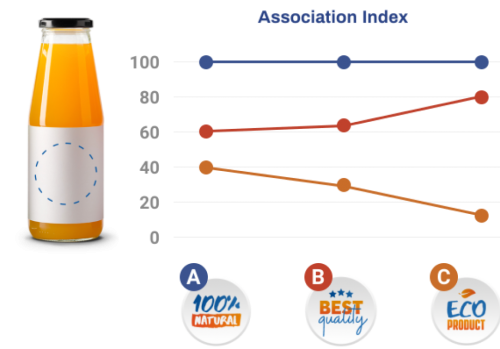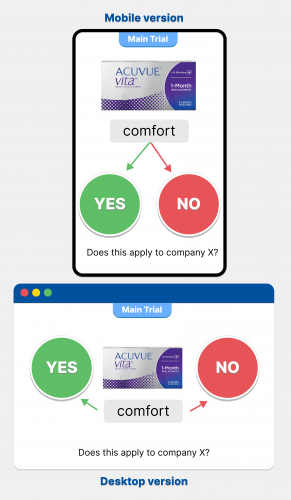How an implicit response test works
Do you know what consumers
associate with your brand?

An implicit test is a research tool that measures subconscious drivers, attitudes, feelings, and social biases.
There are many different kinds of implicit tests that are used in academic studies. They are referred to in many ways, such as implicit response test, implicit reaction time test, and an implicit association test or IAT.
In market research implicit response tests are used to understand feelings towards brands, products, and services. This in turn yields insights into consumer choices and purchase drivers within a market category.

The test mostly used in consumer research is the affective priming test.
It was originally developed by Fazio, Jackson, Dunton, and Williams (1995) and is based on making categorical judgements.
The very first use of the test was to detect target words as either one evaluative category (e.g., Happy) or another (e.g., Sad) by pressing a corresponding button or key on the keyboard.
Once this simple skill has been acquired, the next phase involves presenting a prime before the target. The target word (e.g., Happy) is preceded very briefly by a prime, such as Joy.
The prime is either congruent with the target word (for example, when the prime is Joy and the target is Happy or the prime is Gloomy and the target is Sad) or incongruent (when the prime is Gloomy and the target is Happy, or the prime is Joy when the target is Sad).

A critically important point here, is that congruent trials can be performed quicker and with fewer errors than can be done in incongruent trials.
This means if an attitude towards a brand is congruent with a prime, it can be revealed in this test.
This is an attractive alternative to self-report measures, since it does not rely on subjective responses or depend on any attempt to introspect. Moreover, an implicit test is much harder to fake than a self-report test.
Faking the response is extremely difficult – one would need to know the principles on which the cognitive test is based and then inhibit one’s impulses. It is also easy to detect when respondents press keys randomly (which could add noise to the data) and then easy to ask them to take the test correctly or to evict them from the survey. I have developed hundreds of these tests and even I am unable to fake or trick the test when I have a strong feeling about something.
An Example of An Implicit Response Test (Affective Priming Test)
Just as there are different kinds of implicit tests, there are several different ways of implementing each type. The one described here is the YES-NO test. The test can be taken on a desktop / laptop (involving key presses from the respondent) or on a device with a touchscreen (involving swiping left or right).
In the YES-NO affective priming test, there are two targets. (No surprise) the targets are the words YES and NO. The respondent has to look out for these targets and hit the correct key on the keyboard (or swipe left or right accordingly). For example, they might have to hit C on the keyboard (or swipe left) when they see the word YES appear on the screen. Or, they may have to hit M on the keyboard when they see NO (or swipe right).
The task is always the same – look out for the target and press a key or swipe left or right.
Even if the testing stimulus appears to be inviting a choice, the response is always towards the target and not the prime.
The prime is typically the brand plus one of the attributes. These are flashed on the screen before the target. An attribute is represented by a statement (e.g., “Coca-Cola makes me feel happy”). The prime is flashed on the screen and then removed, followed by the target YES or NO. The response is dictated by the target, the respondent does NOT choose to press YES or NO. They must press for YES when the word YES is presented and they just press for NO when the word NO is presented.
The logic is that if the brand is associated with the attribute then the time taken to press for YES will be quicker than the time taken to press for NO. See the example below:
Repeated over enough trials and respondents, this small difference will become statistically significant. We can infer that Coca-Cola does indeed make the target group feel happy.
In the analysis an Association Index is computed for every potential and indicates the strength of the association between the stimulus (e.g., brand) and the attribute. It produces a score on the scale 0-100, where a score significantly <50 indicates a negative association with the brand (e.g., “Coca-Cola does NOT make me feel happy”) and a score significantly >50 indicates a positive association with the brand (e.g., “Coca-Cola does make me feel happy”). A score too close to 50 suggests no strong association at all (e.g., “In terms of feeling happy, Coca-Cola doesn’t affect my feelings at all”).
The IAT
The most commonly researched implicit measure in academic studies is the Implicit Association Test or IAT (Greenwald, et al., 1998).
Its choice among academic owes itself to the fact that it is a far more lengthier test and it is common for academic testing to last around 50 minutes to an hour, but not so for online consumer testing. There are other reasons why affective priming is preferred, but mentioning the IAT is just to alert the reader that it exists.

An Alternative – The Choice Latency Test
In contrast to an implicit test, where consumers feelings are detected through reaction times to right and wrong answer, in the Choice Response Latency test or (CRL) measures how consumers feel about the brand from their timed choices. They are asked to make overt, explicit evaluations in the form of forced-choices, meaning that they have to choose one thing (e.g., brand 1) over another (e.g., brand 2), there is usually no middle ground (e.g., neither).
In the analysis, we can measure reaction time too, and we would use this to measure confidence – so a quick choice represents high confidence, and a much longer response indicates a high degree of uncertainty. The CRL can be used in the YES-NO format too – the respondent drags a brand statement (e.g., A Mars bar gives me energy) into a YES box or a NO box (or pushes the statement to one of the two boxes on a device with touchscreen).
(See example)
In a brand v brand format, the respondent pushes an attribute (e.g., gives me energy) into the Brand 1 box or the Brand 2 box. In this test, there can be more than 2 brand boxes. So, for example, the respondent may have to decide between 5 brands, (e.g., which they most associate with gives me energy).
An important advantage of using both types (affective priming and CRL) is that their data can be compared directly. In doing so, we can identify very strong or very weak attributes. We can also identify whether some attributes are being exaggerated explicitly (or attributed rationally) and whether some attributes are being under-stated (or felt intuitively/emotionally).
A Note on Whether CRL Tests Are Implicit or Not
A choice response latency test measures how fast someone can make a decision, such as how quickly they choose between two alternatives. For example, by clicking on an object on a computer screen, pressing a key on a keyboard, or dragging and dropping one item onto another using the mouse. According to the psychological literature, fast response latencies indicate easier mental accessibility between the stimulus and an underlying feeling or attitude, or confidence when asked a question requiring Yes or No. Fast responses, such as those less than a threshold (typically 800ms, though some researchers argue for 1000ms), are considered implicit, in the sense that the strength of association is assumed to result from non-conscious or intuitive mental processes – feelings that are not made consciously or rationally.
Uses of this approach are fairly common in the implicit literature: McCartan, R. & Elliot, M.A. (2018), Aaker et al (1980), Bassili & Scott (1996), Busemeyer & Townsend (1993), Hutchinson et al (1994), Fazio (1990). There is quite good evidence that the CRL test is a good measure of confidence and while some claim that faster responses reflect implicit/intuitive responses, others using the method make no such claim other than that it produces greater discriminating responses than untimed choice.
References
Aaker, D. A., Bagozzi, R. P., Carman, J. M., & MacLachlan, J. M. (1980). On using response latency to measure preference. Journal of Marketing Research, 17(2), 237-244. https://doi.org/10.1177/002224378001700208
Bassili, J. N., & Scott, B. S. (1996). Response latency as a signal to question problems in survey research. Public opinion quarterly, 60(3), 390-399. https://doi.org/10.1086/297760
Busemeyer, J. R., & Townsend, J. T. (1993). Decision field theory: a dynamic-cognitive approach to decision making in an uncertain environment. Psychological review, 100(3), 432.
Fazio, R. H., Jackson, J. R., Dunton, B. C. & Williams, C. J. (1995). Variability in automatic activation as an unobtrusive measure of racial attitudes: A bona fide pipeline. Journal of Personality and Social Psychology, 69, 1013-1027.
Greenwald, A., McGhee, D. E. & Schwartz, J. L. (1998). Measuring individual differences in implicit cognition: The implicit association test. Journal of Personality and Social Psychology, 74, 1464-1480.


